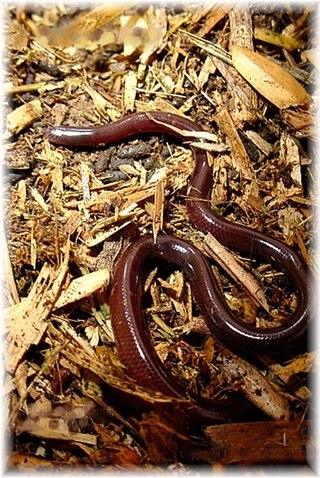
The Typhlopidae are a family of blind snakes. They are found mostly in the tropical regions of Africa, Asia, the Americas, and all mainland Australia and various islands. The rostral scale overhangs the mouth to form a shovel-like burrowing structure. They live underground in burrows, and since they have no use for vision, their eyes are mostly vestigial. They have light-detecting black eye spots, and teeth occur in the upper jaw. Typhlopids do not have dislocatable lower jaw articulations restricting them to prey smaller than their oral aperture. The tail ends with a horn-like scale. Most of these species are oviparous. Currently, 18 genera are recognized containing over 200 species.

Amerotyphlops brongersmianus, known commonly as Brongersma's worm snake or the South American striped blindsnake, is a species of harmless blind snake in the family Typhlopidae. The species is native to South America and Trinidad and Tobago in the Caribbean. No subspecies are currently recognized.

Indotyphlops braminus, commonly known as the brahminy blind snake and other names, is a non-venomous blind snake species found mostly in Africa and Asia, but has been introduced in many other parts of the world. They are completely fossorial reptiles, with habits and appearance similar to earthworms, for which they are often mistaken, although close examination reveals tiny scales and eyes rather than the annular segments characteristic of true earthworms. The species is parthenogenetic and all known specimens have been female. The specific name is a Latinized form of the word Brahmin. No subspecies are currently recognized.

Typhlops is a genus of blind snakes in the family Typhlopidae. The genus is endemic to the West Indies. Some species which were formerly placed in the genus Typhlops have been moved to the genera Afrotyphlops, Amerotyphlops, Anilios, Antillotyphlops, Argyrophis, Cubatyphlops, Indotyphlops, Letheobia, Madatyphlops, Malayotyphlops, and Xerotyphlops.

The Scolecophidia, commonly known as blind snakes or thread snakes, are an infraorder of snakes. They range in length from 10 to 100 centimetres. All are fossorial. Five families and 39 genera are recognized. The Scolecophidia infraorder is most likely paraphyletic.
Anilios australis, or the southern blind snake, is a species of snake in the family Typhlopidae. The species is endemic to Australia.
Anilios broomi, also known commonly as Broom's blind snake, the faint-striped blind snake, and the striate blind snake, is a species of non-venomous snake in the family Typhlopidae. The species is endemic to Australia.
Anilios diversus, or the northern blind snake, is a species of snake in the family Typhlopidae. The species is endemic to Australia.
The long-beaked blind snake is a species of snake in the family Typhlopidae, first described in 1918 by Edgar Waite as Typhlops grypus, and endemic to northern Australia.
The Top End blind snake is a species of snake in the family Typhlopidae. The species is endemic to Australia.
The Kimberley deep-soil blind snake is a species of snake in the family Typhlopidae. The species is endemic to Australia.
The buff-snouted blind snake is a species of snake in the family Typhlopidae. The species is endemic to Australia.
Anilios silvia, also known commonly as the great sandy blind snake or Sylvia's blind snake, is a species of snake in the family Typhlopidae. The species is endemic to northeastern Australia.
The Darwin blind snake is a species of snake in the family Typhlopidae. The species is endemic to Australia.
The beaked blind snake, also known commonly as Waite's blind snake, is a species of snake in the family Typhlopidae.
The brown-snouted blind snake, also known commonly as Wied's blind snake, is a species of snake in the family Typhlopidae. The species is endemic to Australia.
Conrad's worm snake is a species of snake in the family Typhlopidae. The species is endemic to Indonesia.
Argyrophis klemmeri, also known as Klemmer's blind snake or the Kuala Lumpur worm snake, is a species of Asian snake in the family Typhlopidae.
Anilios ganei, also known commonly as Gane's blind snake, is a species of snake in the family Typhlopidae. The species is endemic to Australia.
Anilios vagurima, also known as the Mornington blind snake, is a species of blind snake that is endemic to Australia. The specific epithet vagurima refers to the diagnostic morphology of the cleft in the nasal scale.









